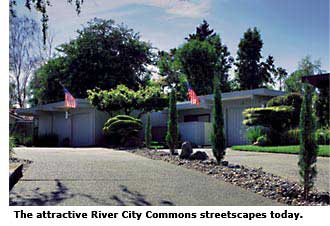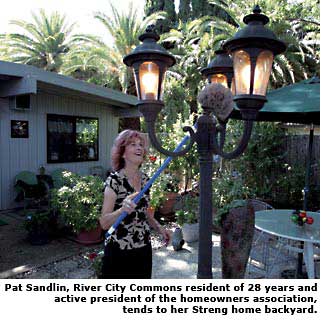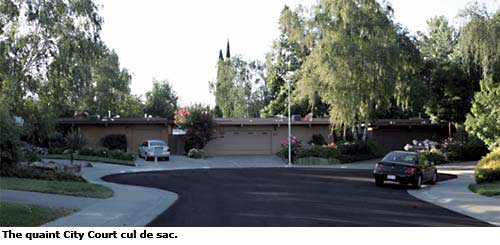Renewing River City Commons - South Natomas, Sacramento
 Despite her red hair, Pat Sandlin is no firebrand. In fact, she's rather folksy. But she's far from laissez-faire when it comes to protecting her neighborhood, the modern Streng Bros. enclave of River City Commons. Sandlin has lived there for 28 years, since it was new.
Despite her red hair, Pat Sandlin is no firebrand. In fact, she's rather folksy. But she's far from laissez-faire when it comes to protecting her neighborhood, the modern Streng Bros. enclave of River City Commons. Sandlin has lived there for 28 years, since it was new.
During that time she's seen the subdivision, in Sacramento's neighborhood of South Natomas, go from mustard fields to modern suburbia. She's seen the easy-going camaraderie of the early days, when most residents were young singles and neighborhood barbecues were common, shift, as singles were replaced by young families. It shifted again, as young families morphed into older couples and retirees.
She saw more and more homes fall into the hands of what she calls "non-resident owners" who let them slide. Sandlin refuses to blame renters, who make up 24 percent of her neighbors. But she saw more and more properties suffer from neglect.

So Sandlin acted. Recently retired herself, she joined the board of the River City Commons Association in 2004 determined to clean things up. The last thing she wanted to hear was this complaint voiced by several non-resident owners. "I don't know what the fuss is about," several told her. "This is just a rundown neighborhood."
"I took exception to that," she says. "Our homes weren't run down."
Sandlin, who's been president of the River City Association board since 2005, makes sure of that. The association has become far more active since she got involved—re-involved, actually, as she had also served on the association's first board, way back in 1979. Back then a fellow board member was Jim Streng, who had developed the neighborhood with his brother Bill.
"One person certainly can't do this alone," Sandlin says, crediting the entire five-member board with working hard to improve the neighborhood. Board member Virginia Thomas, for example, helps inspect properties to determine which need better upkeep.
"I served as a catalyst to a board that wanted to do something but perhaps didn't have that impetus to move forward," Sandlin says. She notes that, as a federal court administrator, her expertise was "leading people into making changes."

Over the past decade or so, "Things had declined," says Denise Jerome, a member of the association's architectural committee. "We even had a few yards that were just dirt."
"There was a sense overall that the neighborhood was getting a little scruffy around the edges," says Harriet Kallemeyn, the board's secretary, a newcomer who arrived at River City in 2003. "It's a new board, and people are trying to bring up the entire area."
The board brought in a new property management firm, visually inspected every property in the neighborhood, and sent out notices ordering repairs to owners whose properties needed work. "People weren't used to that," Sandlin says. "That hadn't been done before."
One of those notices went to Sandlin herself. Her driveway was cracked, a "trip-and-fall hazard."
The board also took on the job of maintaining the privately owned street-side landscaping along Truxel Road, the main thoroughfare that runs past the neighborhood. The condition of the sidewalk strip wasn't adding to River City Commons' allure.
To pay for all this, dues were raised from $40 to $50 a month, then $60. "People thought that outrageous," Kallemeyn says, though she says it's a bargain compared with nearby home associations.
Now the board is updating its outdated 1978 homeowner covenants, and proposing a clause that would cap the number of renters at 25 percent. It is also strengthening architectural guidelines and plans to enforce them—something that didn't always happen in the past. The rules would give the board oversight over any changes to a home that can be seen from the street.

And River City Commons has plenty of architectural integrity to protect. Almost all of the homes retain, to a great extent, their original architectural look. Its architect, Carter Sparks, was one of Sacramento's leading modernists—and one of the few architects anywhere to succeed in fulfilling the modernist dream of designing entire neighborhoods of modern homes for working class and middle-income people.




